Description
Dark Magic of Unutterable Evil!
“A field produces no crops until the farmer slices it open with a blade.” – Mstislav, Butcher of the Steppes
Antipaladins and blood mages are amoral, self-centered, and uncompromising. This is a bad combination where party harmony is concerned—but they make excellent evil NPCs and villains for your campaign.
Deep Magic: Blood and Doom contains the secrets of antipaladin and blood magic for 5th Edition, featuring:
- Antipaladin class features and magic, including Unholy Smite, Oath of the Giving Grave, Aura of the Unrepentant, and Undying Sentinel
- A new Serophage sorcerous origin, featuring Strength Beneath the Skin, Blood Fuel, Blood Barrier, and Exsanguinate
- A Blood Magic Wizard School with 36 horrifying spells that include animate ghoul, doom of consuming fire, strength of the underworld, and vomit tentacles
- A new blood elemental monster, and a new wondrous item: Taergash’s Exsanguinating Tome
Undying riders thunder across the land, bringing death in their wake. Corrupt wizards, clerics, and sorcerers recite twisted spells from blood-drenched grimoires and bile dripping tomes. Your heroes have long sought foes worthy of their steel—but nothing prepared them for this.

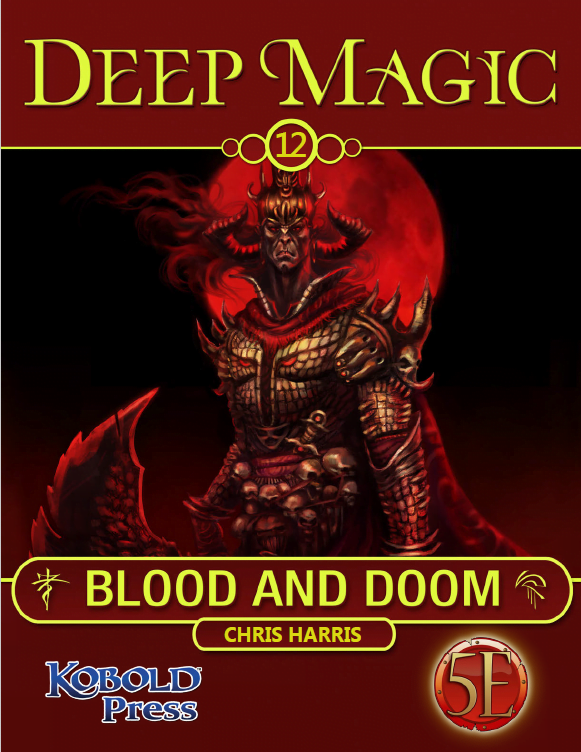
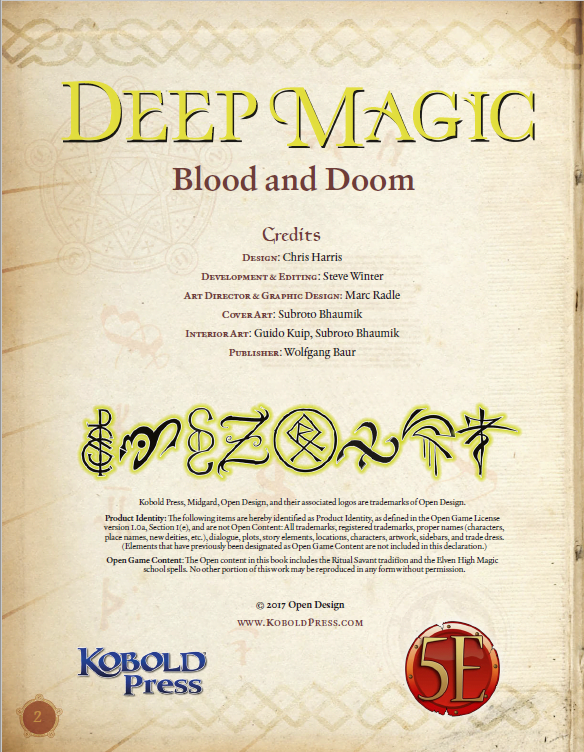
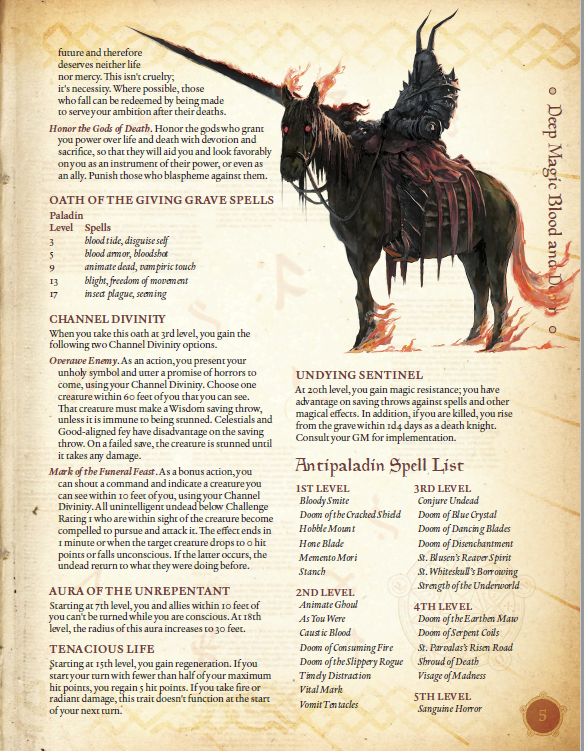
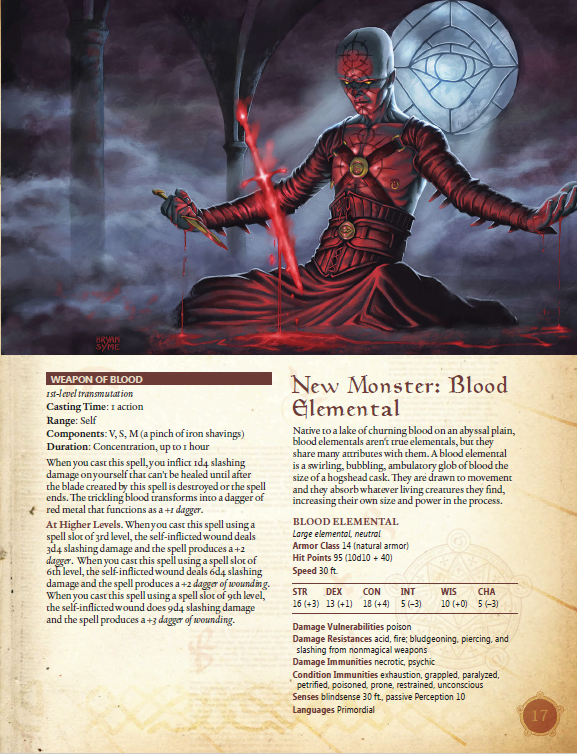
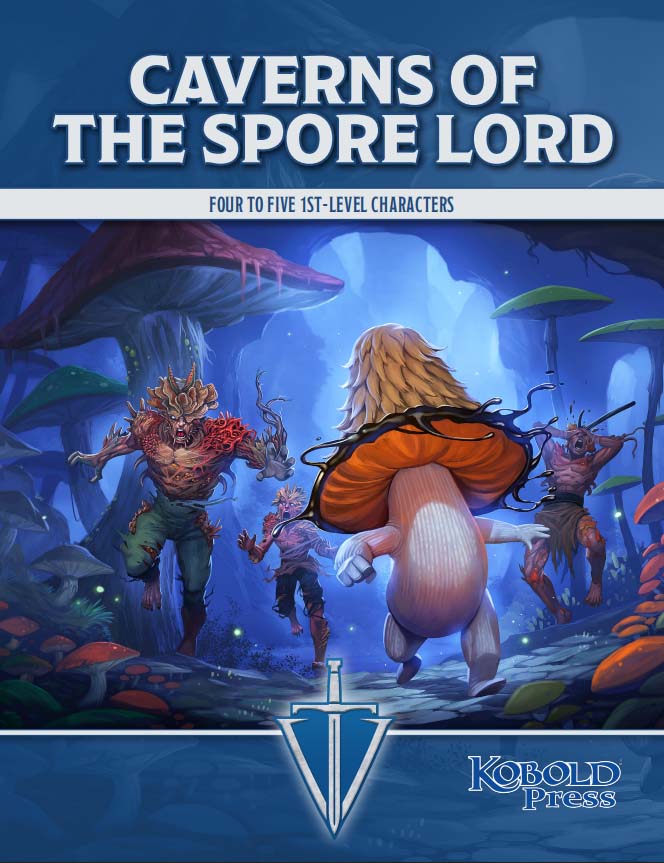
Thilo Graf –
An Endzeitgeist.com review
This installment of Kobold Press‘ Deep Magic-series clocks in at 19 pages, 1 page front cover, 1 page editorial, 2/3 of a page SRD, 1 page advertisement, leaving us with 15 1/3 pages of content, so let’s take a look!
So, the first thing you need to know is that we get a new sacred oath herein – The Giving Grave. This oath, however, represents more the concept of the antipaladin, rather than the paladin. As some 5e-players are wont to claim, the paladin class is removed from its LG-shackles in 5e; while technically true, the class features and general build don’t really lend themselves well to representing the concept of the anipaladin per se, which is why we begin with two alternate class features that a paladin en route to swearing the oath to darkness receives: Unholy Smite replaces Divine Smite, changing the damage type to necrotic and the particularly hard-hit targets to celestials, good-aligned fey and dragons. Improved divine smite, at 11th level, is similarly replaced with an evil variety, inflicting necrotic damage. Cool for stories of fallen warriors – synergy is possible, but not required by the rules. Interesting: Lay on hands is retained RAW and we do get an alternate spell list for evil paladins herein.
The sacred oath of the giving grave requires that you honor the gods of death, seek to overcome mortality, serve those that can teach and brook no opposition to your ambition. The oath grants two channel divinity options: Overawe enemy can stun a target within 60 ft. for 1 minute (or until damaged) on a failed save, with good-aligned fey and celestials suffering from disadvantage on the save. Mark of the Funeral Feast lets you indicate, as a bonus action, a creature within 10 ft. that you can see. All undead the creature can see with a challenge below 1 are compelled sans save to attack it. This is slightly inelegant, as it is based on the sight of the target, when imho, one based on the paladin would make more sense, but oh well.
7th level provides an aura that prevents being turned, with a 10 ft.-radius that increases to 30 ft. at 18th level. At 15th level, whenever the (anti)paladin begins the round with less than half maximum hit points, he gains 5 hit points. Fire or radiant damage causes this feature to cease working for 1 round. Not a fan there – wouldn’t allow that for my players, but YMMV. The capstone ability nets magic resistance: Advantage on saves versus all spells and magical effects. If you die, you rise from the grave in 1d4 days as a death knight.
Now, the title of this pdf is “Blood and Doom” – we’ve taken a look at the doom component, but what about the blood? Well, blood magic is represented first by the legendary wondrous item Taergash’s Exsanguinating Tome, which requires attunement by a wizard. Wrapped in filthy, blood-weeping covers, the spellbook contains some of the dark secrets of blood magic. There are two class options to represent blood magic specialists, the first of which would be the Serophage sorcerous origin. The origin grants limited control over your own blood: When taking bludgeoning damage, you roll 1d4 and subtract it from the damage taken (note: This applies to damage TAKEN, as such, resistance is applied first – spelling that out would have made sense, but that is aesthetic nitpickery on my side and won’t influence the verdict), which increases to 1d6 at 6th level.
6th level provides the Blood Fuel feature: You can increase the save DC of the next spell you cast by +1 for inflicting 1d4 slashing damage to yourself instead of moving. Alternatively, instead of moving, you can inflict 1d4 slashing damage on yourself to regain the same amount of sorcery points. 12th level increases the DC-boost to +2 and the die of damage caused to yourself to d8. Yeah, this is utterly broken. Flexible casting lets you use sorcery points to create spell slots and vice versa – and this utterly delimits the resource. If the origin lost this feature, it’d still be borderline OP – with it, any curative option becomes basically an arcane battery. Not getting anywhere near my game. This really nets a limiting factor based on rest interval or at the very least a caveat that the damage can’t be healed for a couple of long rests. The 14th level ability, blood barrier, lets you draw blood from a creature that was killed with 30 minutes and form it into swirling rings – one ring per point of Charisma modifier. Kudos: It can’t be kitten’d – the creature must have at least an Intelligence of 5. Problem: The feature fails to specify its activation action. The rings absorb physical damage – when hit by a physical melee or ranged attack, one ring absorbs 1d10 damage and then vanishes in a splash. Note that this happens BEFORE the taking of damage, i.e. before resistance etc. is applied. Alternatively, as an action, you can form a ring into a spear of blood and launch it as a ranged spell attack: On a hit, the target takes 1d6 + Cha-mod piercing damage and must succeed a Con-save to avoid being stunned until the start of your next turn.
18th level nets exsanguinate, wherein you target a creature within 40 ft. as an action. On a failed Con-save, the creature takes 2d6 necrotic damage – the damage caused causes blood to fly towards you. For each 2 points of damage thus caused, you regain 1 hit point or one sorcery point. The effect remains until the target makes its save, continuing to replenish you. Oh boy. Here, we have no kitten-caveat: You can carry around a bag of harmless kittens and drain them to your heart’s content. This feature delimits BOTH sorcery points AND hit points – infinite healing and infinite spell slots of up to 5th level. WTF. I have no idea how this got past the developer. This really needs a rest-interval cap of uses.
The second class option dealing with blood magic would be a tradition for the wizard class. Here, we begin at 2nd level with blood savant, which halves costs and time required of blood magic spells to be integrated into the spellbook. It also nets proficiency in Medicine. Additionally, when subjected to a disease or poison that causes half damage on a successful save, you instead take none on a success, half on a failure. 6th level nets Blood Vision, which lets you ingest another creature’s blood, I assume as an action, but the ability does not specify it. You are stunned for 1 round when doing so, but gain a vision of one memory of the creature, depicting the instance that caused it to bleed. Only one ingestion per creature is allowed, though.
10th level unlocks Absorb Impurities: It allows you to touch a fresh cut or source of disease or poison and harmlessly draw it into you, dormant– I assume, this requires an action. You can then, as an action, spit a stream of blood as a ranged spell attack at a target, who then must save against the poison/disease. You can only carry a poison or disease for a certain amount of time – failing to divest yourself of it will result in seriously nasty saves against it. I like the flavor here – but what’s the range of the blood-spit? No idea. 14th level nets the option to haste or slow a creature for Intelligence modifier rounds on a failed Con-save. RAW, this does not require that you can see the creature and it can be used 1/day, which is uncommon in 5e.
Oh boy, not sure what happened with the blood magic class options – they’re uncharacteristically problematic. Let’s see whether the massive spell-selection fared better.
The pdf provides a new cantrip, Blood tide, which causes the target to bleed from facial orifices sans damage, but imposes a -2 penalty on Int-, Wis- and Cha-checks. It may be cured via Medicine and healing magic and may attract bloodsuckers. Duration increases later.
At 1st level, we have bloody smite, which is a variant of searing smite that replaces fire with necrotic damage and uses Medicine or healing magic to staunch the blood flow. Doom of the cracked shield is cast upon a weapon and held therein until expended, which will then destroy the next nonmagical shield/armor it strikes – shields are reduced to rust and sawdust, while armor reduces its effectiveness by 2 points. I assume that reduction to 0 destroys the armor, but the spell doesn’t specify that. Hobble mount causes a beast that is being ridden and touched to be disabled, taking damage upon moving, with more damage at higher levels. Only mounts may be affected. Hone blade nets the weapon +1 damage on the next successful hit. Memento mori lasts only one round, but makes all creatures that see you succeed a Charisma saving throw of be stunned for one round – ouch! Thankfully, a creature that succeeds the save can’t be affected again for 24 hours. Stanch stabilizes a dying character and prevents the use of the character for spells or effects requiring blood, justifying the 1st-level spell slot versus the spare the dying cantrip. Weapon of blood causes 1d4 damage to you that can’t be healed to make a +1 dagger from blood. The damage may not be healed until the spell ends or the blade is destroyed. Higher levels allow for the inflicting of more damage for progressively better magical daggers.
At 2nd spell level, we get the vomit tentacles spell, which is a melee spell attack with a range of 15 ft., causing 2d6 bludgeoning damage and grappling the target. The target is restrained until it escapes (DC = spell save DC) and takes 2d6 + Str-mod damage on each of your subsequent turns. Tentacles may be severed by slashing attacks and regrow on your next turn. You can’t speak while the spell is in effect. Cool one! Timely distraction has a 25 ft.-range and causes a random condition on a failed save, with saves on subsequent rounds to end them. Doom of the slippery rogue coats a 20 x 20 ft. area of a wall or floor with slicky grease, causing chances of targets to fall from climbing or fall prone. Pretty sure there is no Dexterity (walking) check, though – that should probably be (Acrobatics). As an aside – Grease, as a precedent, requires a save, not a check. Doom of consuming fire causes 3 (1d6) cold damage to you every round, while creatures within 5 ft. take 4 (1d8) while the spell is in effect – weird: Spells usually don’t list averages. Higher spell slots increase the damage caused. Wonky: The spell should probably specify that the damage it causes doesn’t trigger saves to retain concentration on the spell.
Caustic blood lets you use your reaction to taking damage to select 3 targets within 30 ft. These take acid damage on a failed save. I like the visuals here, but the spell RAW is weird: The casting time is “1 reaction”, failing to specify TO what; conversely, RAW, the spell doesn’t trigger until after the round it has been cast, which I’m pretty sure isn’t how it’s supposed to work. Bloodshot makes you take necrotic damage and a ranged spell attack with a 40 ft. range; on a hit, the target takes both fire and psychic damage. Higher levels increase the fire damage. I don’t really get where psychic damage comes from here, but oh well. Blood lure does what it says on the tin, attracting blood-feeding creatures and predators, with penalties for those that have a keen sense of smell. Nice one. Animate ghoul does what it says on the tin. As you were returns a dead creature’s appearance to how it looked in life, when healthy and hale. On a corpse, this duplicates gentle repose; on an undead, it can act as a neat disguise. Like it!
The 3rd level spells include blood armor, which you can cast as a bonus action when hitting a foe with a melee weapon; the blood flows forth and creates an AC 18 + Dex-mod armor sans Str-requirement. It doesn’t hinder spellcasting and when drawing the blood from a celestial, you also get advantage on Cha-saves while the spell persists. Conjure undead creates a shadow to do your bidding, with higher spell levels providing wights or ghosts as alternatives. Doom of blue crystal lasts 3 rounds and affects targets within 5 ft., including yourself – first, you save to avoid being restrained; then, to avoid being paralyzed and if you botch a third save against the spell, you become petrified. Crystallized creatures can be shattered for insta-death on a failed save. Doom of dancing blades creates 1d4 illusory copies of your weapon. When hit by a melee attack, but within 3 of your AC, one of the weapons intercepts the attack, destroying the weapon. If the weapon fails to parry an attack, a blade is still destroyed, and you take half damage. On a successful crit, you add +1d8 damage of a physical type of your choice per blade. Doom of disenchantment negates numerical bonuses to hit and damage, suppressing magical or spell-like abilities of the weapon, in which case, the effect is treated as affected by a Cha-based counterspell. This one is pretty strong – frankly, I’d limit it, with higher spell slots tied to spell-level and item rarity.
St. Blusen’s reaver spirit nets you and all allies within 30 ft. that can see you advantage on Str-checks, Str-saves, resistance to all 3 physical damage types from nonmagical weapons and +2 to damage with melee attacks, but when the spell ends, all characters affected by it gain 1d4 exhaustion levels. Higher levels increase the melee damage bonus – Cool one! St. Whiteskull’s borrowing allows you to touch a target, gaining one sense, movement type and speed, feat, language, immunity or extraordinary ability. You can borrow only one ability at once and may target freshly dead targets and living alike: Unwilling targets get a save. A higher level option makes the target lose the borrowed quality and increases the duration. Weird: Why can you borrow immunities, but not resistances? It would make more sense to only allow for resistance borrowing. Not a fan. Strength of the underworld nets advantage on saves versus Turn Undead or helps the chance to revive as a darakhul. Vital mark marks a magic item with a stain of your blood, preventing it from functioning as magic for anyone but you. It can be made permanent with higher level and consecutive use. Two thumbs up here!
At 4th level, we have visage of madness, which causes all foes that can see you within 30 ft. make a Wisdom save, inflicting 1d6 + the creature’s Str-mod damage to itself on a failed save, stunning it for 1 round and blinding it for 1d4 rounds. On a 6 on the damage roll, the blindness is permanent. This should probably have a caveat that it doesn’t stun fiends or servants of demon lords (as the visage of such a lord causes the effect) and that creatures immune to piercing damage can’t blind themselves. Shroud of death causes all creatures within 30 ft. to take 1 point of necrotic damage, which you gain as temporary hit points, increasing the damage by +1 on every subsequent round. This is spell can be abused in a needlessly dumb manner. Take a big bag o’ kittens. Throw it in the field. Gain buttload of temporary hit points. Sure, it doesn’t last long, but why not provide a proper caveat?? St. Parvala’s risen road is cool, as it open a path into one of the shadow roads, the dark passageways of the shadow fey. Doom of the earthen maw makes the area of a point within 60 ft. turn filthy, slippery muck in a 30 ft.-radius, creating difficult terrain. Targets in the area must make a Strength save or be restrained. Creatures that save don’t become restrained, but those that are risk sinking deeper on subsequent rounds, potentially suffocating when having sunk beneath the muck. Doom of serpent coils requires that you drink a poison, autofailing the save. The effect of the poison is then spread to all targets within 10 ft., using he spell save DC instead of the one of the poison. Instead of a poison’s usual effects, such targets instead take fixed poison damage (providing average values as well as the dice) and are poisoned. Success renders immune to the spell for 24 hours. Weird: RAW, characters immune to poison can avoid the self-poisoning component, which, I’m pretty sure, was not intended.
Blood and steel makes you cut yourself, which can’t be healed until you finish a long rest. You then touch a construct, which must succeed a Con-save or be charmed. Constructs you fight have advantage on the save and the charm-effect bypasses char-immunity. You can provide general orders with a telepathic link; or you can exert full control over it as an action, using your reaction to make it use its own reaction. Constructs already under your control become sentient for the duration and gain a bonus equal to your Int-mod to a skill they’re proficient in. Higher spell slots increase the duration. Blood spur provides a blood hound like straight vector to your quarry, even helping you to keep track of magical movement. Cool one. For 5th spell level, we get cruor of visions, which is a blood-based scrying variant, with higher spell slots duplicating progressively better crystal ball effects in conjunction with it. Exsanguinating cloud creates a blood-leeching cloud…that fails to specify its dimensions, making it non-functional as written and impossible to determine how it’s supposed to work. Sanguine horror conjures forth a blood elemental – a new creature herein: They clock in at challenge 5 and represent a nice critter, making good use of 5e’s dynamic damage types and rock-paper-scissors mentality.
Conclusion:
Editing and formatting on a formal level are very good – a missing hyphen here and there is as bad as it gets. On a rules-language level, the same can’t be said. From the utterly broken sorcerous origin to several rules-issues in spells etc., the pdf could have seriously used some careful rules-editing. Layout adheres to a really nice two-column full-color standard and the pdf comes with basic bookmarks for the chapter headers. The full-color artworks are nice, but fans of Kobold Press will be familiar with them.
I don’t get it. Chris Harris’ work is usually much better than this. While the pdf sports several really cool spells and angles and has some interesting design choices, there are a lot of flaws in this. Regarding rules-integrity, this is one of the weakest, if not perhaps the weakest of the Deep magic-installments I’ve reviewed so far. My final verdict will clock in at 2.5 stars, rounded up due to in dubio pro reo.
Endzeitgeist out.
zgaspinall –
It adds in some very interesting things in terms of flavor and effectiveness, I especially like the way it helps to add some more in between spells for necromancers focusing on undead raising. While some spells are op they can be easily changed to fit proper standards. And it should be said, Before the spell description section it clearly states the spells in this book were designed for NPCS and Villains, not for player charecters, along with the fact dm consultation will be required
I ran some of this stuff, after a bit of balancing, as both a player and dm to test it. Works good for the aesthetic, but if you want to do this as a player a bit of editing is required. To be fair though, I have never been someone who cared a whole lot about exact wordings as long as function is understood and no one cheeses with it. So take my opinion with a grain of salt.